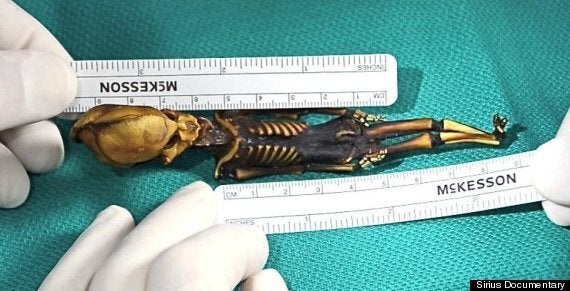For ten years, speculation has raged over the origins of the mummified remains of this six-inch “space alien” discovered in Atacama, Chile.
Known as the Atacama Humanoid, it has been variously thought to be an aborted fetus, an extra-terrestrial or a primate.
Now upcoming UFO documentary Sirius will cast light on just what “Ata” is.

The Atacama Humanoid was found in the Chilean desert in 2003
Ata was reportedly discovered by a man searching for objects of historical value near an abandoned church in La Noria, in Chile’s Atacama desert in 2003.
Open Minds quotes Oscar Munoz as finding: “A strange skeleton, no bigger than 15cm [the size of a pen]. It was a creature with hard teeth, a bulging head with an additional odd bulge on top. It’s body was scaly and of dark colour. Unlike humans, it had nine ribs.” [Later reports say the specimen has ten ribs].
Ata changed hands several times before coming into the possession of Barcelona entrepreneur Ramon Navia-Osorio, the head of UFO organisation the Institute for Exobiological Investigation and Study (IEE).
In a report for Argentinian news website Realidad OVNI (UFO Reality), Navia-Osorio describes how he has had the creature repeatedly analysed, with one study by three doctors determining whatever Ata was, he was not a hoax.
Despite earlier Sirius promotions suggesting DNA analysis of Ata resulted in the creature being of “unknown classification”, a Hollywood premiere on Monday revealed Ata was a human male.
Gary Nolan, director of stem cell biology at Stanford University’s School of Medicine in California, who features in the documentary, said: “I can say with absolute certainty that it is not a monkey. It is human – closer to human than chimpanzees. It lived to the age of six to eight.
“Obviously it was breathing, it was eating, it was metabolising. It calls into question how big the thing might have been when it was born."
Of the DNA tests he carried out, he adds: “The sequence that we got from the mitochondria [energy factories of cells] tells us with extremely high confidence that the mother was an indigenous Indian from the Chilean area. The other thing that immediately fell out of the analysis is that it's male. It probably died in the last century, if I were to make a guess."
In a report and summary published online, Dr Nolan says the specimen had "an apparently severe form of dwarfism and other anomalies."
However he concedes: "The observed abnormalities do not fall into any standard or rare classification of known human pediatric disorders.
SEE ALSO:
"As the current list of human disorders is far from complete and many human disorders are polygenic, there might remain to be found a combination of mutations working in concert that lead to the observed defect(s)."
Future studies are planned and other questions must be addressed, he adds, the answers of which he plans to publish in an accredited scientific journal.
The film also explores an ongoing grassroots movement to get the U.S. government to reveal what it reportedly knows about UFOs, extraterrestrials and the availability of advanced alternative energy technologies.
The primary force behind "Sirius" is Steven Greer, a former emergency room doctor who founded the Center for the Study of Extraterrestrial Intelligence (CSETI) and The Disclosure Project.
Strangely, Dr Greer seems less keen to concede the identity of Ata. His own full report, also published online, states "the Atacama Humanoid remains a profound mystery."
He adds: "Clinically, given that this humanoid lived many decades to centuries ago, it is hard to understand how a six inch baby or child could have lived to be 6-8 years of age in such a remote and undeveloped part of the world. Even in today's best Neonatal Intensive Care Unit (NICU) we would hardly be able to keep such a specimen alive.
"As an emergency physician, I have delivered premature infants, as well as a significantly deformed one with anencephaly, and am struck by how small and fragile this humanoid is. Medically speaking, IF this is merely a deformed human, it does not seem feasible that he would have lived to be 6-8 years of age. Speaking as a clinician, I, as well as other doctors with whom I have spoken, doubt he would have lived 6 hours. consistent with a human fetus of this size."